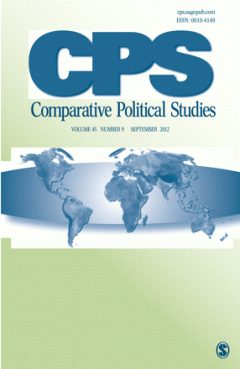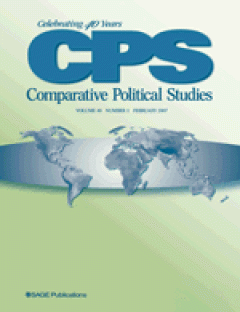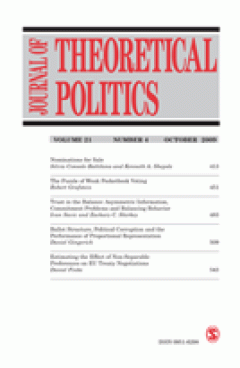Filter by

Policies That Strengthen Fatherhood and Family Relationships : What Do We Kno…
As described in earlier articles, children whose parents have higher incomes and education levels are more likely to grow up in stable two-parent households than their economically disadvantaged counterparts. The widening gaps in fathers’ involvement in parenting and in the quality and stability of parents’ relationships may reinforce disparities in outcomes for the next generation. This articl…
- Edition
- Vol. 635 no. 1, May 2011,pp. 216-239
- ISBN/ISSN
- 00027162
- Collation
- -
- Series Title
- The ANNALS of the American Academy of Political and Social Science
- Call Number
- -

Income Support Policies for Low-Income Men and Noncustodial Fathers : Tax and…
Both wages and labor force participation have been declining for young, less-educated men since the mid-1970s. The purpose of this article is to examine how key income-security policy areas—including unemployment insurance, payroll taxes and the Earned Income Tax Credit, and child support enforcement—affect these men. The article concludes with policy recommendations to improve the impact of wo…
- Edition
- Vol. 635 no. 1, May 2011.pp. 240-261
- ISBN/ISSN
- 00027162
- Collation
- -
- Series Title
- The ANNALS of the American Academy of Political and Social Science
- Call Number
- -

Family Change and Time Allocation in American Families
Delayed marriage and childbearing, more births outside marriage, the increase in women’s labor force participation, and the aging of the population have altered family life and created new challenges for those with caregiving demands. U.S. mothers have shed hours of housework but not the hours they devote to childrearing. Fathers have increased the time they spend on childcare. Intensive childr…
- Edition
- Vol. 638 no. 1, November 2011,pp. 21-44
- ISBN/ISSN
- 00027162
- Collation
- -
- Series Title
- The ANNALS of the American Academy of Political and Social Science
- Call Number
- -

The Cost of Workplace Flexibility for High-Powered Professionals
The authors study the pecuniary penalties for family-related amenities in the workplace (e.g., job interruptions, short hours, part-time work, and flexibility during the workday), how women have responded to them, and how the penalties have changed over time. The pecuniary penalties to behaviors that are beneficial to family appear to have decreased in many professions. Self-employment has decl…
- Edition
- Vol. 638 no. 1, November 2011,pp. 45-67
- ISBN/ISSN
- 00027162
- Collation
- -
- Series Title
- The ANNALS of the American Academy of Political and Social Science
- Call Number
- -

Phased Retirement and Workplace Flexibility for Older Adults : Opportunities …
Phased retirement programs that allow older workers to reduce their hours and responsibilities and pursue more flexible work schedules could satisfy both the employee’s desire for flexibility and the employer’s need to maintain an experienced workforce. However, few employers have established formal programs, because they often complicate the provision of other benefits and might violate antidi…
- Edition
- Vol. 638 no. 1, November 2011,pp. 68-85
- ISBN/ISSN
- 00027162
- Collation
- -
- Series Title
- The ANNALS of the American Academy of Political and Social Science
- Call Number
- -

Workplace Flexibility and Worker Agency : Finding Short-Term Flexibility with…
“Worker agency”—the idea that workers have free will and will exercise it to meet their needs—is a fundamental part of organizational psychology and the sociology of work. Drawing on qualitative research conducted in a midwestern factory, the authors examine how workers create opportunities for short-term flexibility within a workplace characterized by shift work, strict production quotas, and …
- Edition
- Vol. 638 no. 1, November 2011,pp. 86-102
- ISBN/ISSN
- 00027162
- Collation
- -
- Series Title
- The ANNALS of the American Academy of Political and Social Science
- Call Number
- -

The Human Face of Workplace Flexibility
This article reviews several recent studies on working families and discusses the importance of why workplace flexibility needs to become a standard of the U.S. workplace. Most children reside in households with either two employed parents or an employed single parent. The inflexibility of work and school schedules is a pressure that working parents feel on a daily basis and one that affects th…
- Edition
- Vol. 638 no. 1, November 2011,pp. 103-122
- ISBN/ISSN
- 00027162
- Collation
- -
- Series Title
- The ANNALS of the American Academy of Political and Social Science
- Call Number
- -

Workplace Flexibility and Daily Stress Processes in Hotel Employees and Their…
This research aims to understand the consequences of inadequate workplace flexibility through the lens of daily stress processes. Using a sample of hourly paid hotel employees with children ages 10 to 18 who participated in a daily diary study, the authors compared workers with low and high flexibility on stressor exposure, reactivity, and transmission. The findings showed a consistent pattern …
- Edition
- Vol. 638 no. 1, November 2011,pp. 123-140
- ISBN/ISSN
- 00027162
- Collation
- -
- Series Title
- The ANNALS of the American Academy of Political and Social Science
- Call Number
- -

Keeping Women in the Science Pipeline
Premier science largely depends on the quality of the pool of future scientists. Women now represent a large part of the talent pool in the United States, but many data sources indicate that they are more likely than men to “leak” out of the science pipeline before obtaining tenure at a college or university. The authors’ research examines this issue in detail, drawing on multiple sources, incl…
- Edition
- Vol. 638 no. 1, November 2011,pp. 141-162
- ISBN/ISSN
- 00027162
- Collation
- -
- Series Title
- The ANNALS of the American Academy of Political and Social Science
- Call Number
- -

Military Families : Extreme Work and Extreme “Work-Family”
While the U.S. military might at first glance appear to be a model of rigidity rather than flexibility, there are strong incentives to address the work-family concerns of service members and their families. From a work-family perspective, military service generates substantial structural, energy, psychological, and behavioral tensions with family life. Although the U.S. military had already imp…
- Edition
- Vol. 638 no. 1, November 2011,pp. 163-183
- ISBN/ISSN
- 00027162
- Collation
- -
- Series Title
- The ANNALS of the American Academy of Political and Social Science
- Call Number
- -

Democracy Promotion, Civil Society Building, and the Primacy of Politics
Since 1991, Western bilateral and multilateral democracy promotion assistance, especially for civil society development, has increased dramatically. Much of the literature that assesses the impact of this assistance has focused on either direct recipients in civil society or macro transformations, with minimal systematic analysis of how developments in civil society unfold. This article argues …
- Edition
- Vol. 45 no. 1, January 2012,pp. 3-31
- ISBN/ISSN
- 00104140
- Collation
- -
- Series Title
- Comparative Political Studies
- Call Number
- -

China and India in the Age of Globalization : Sectoral Variation in Postlibe…
In recent years, China and India have extensively liberalized their economies. They have departed from the East Asian developmental states, which have restricted foreign direct investment (FDI) to protect domestic industry, and the liberal FDI strategy of Latin America during a similar stage of development as they have eschewed dependent development. Instead, they have taken a “liberalization t…
- Edition
- Vol. 45 no. 1, January 2012,pp. 32-61
- ISBN/ISSN
- 00104140
- Collation
- -
- Series Title
- Comparative Political Studies
- Call Number
- -

Out of the Cabinet : What Drives Defections From the Government in Presidenti…
This article challenges a key part of the conventional view of coalitions in presidential systems that sees them as short-lived and ad hoc. The author shows instead that there is wide variation in the durability of governing coalitions across these regimes. She develops a theory of the incentives of parties to participate in the government and the circumstances under which scholars might expect…
- Edition
- Vol. 45 no. 1, January 2012,pp. 62-90
- ISBN/ISSN
- 00104140
- Collation
- -
- Series Title
- Comparative Political Studies
- Call Number
- -

Constructing Accountability : Party Position Taking and Economic Voting
A positive relationship between economic performance and support for incumbents is routinely taken as evidence that elections work for accountability. Recent investigations into this relationship have examined just how signals from the economy translate into popular support. However, neither selection models nor sanctioning models explicitly incorporate the actions of political elites. This art…
- Edition
- Vol. 45 no. 1, January 2012,pp. 91-118
- ISBN/ISSN
- 00104140
- Collation
- -
- Series Title
- Comparative Political Studies
- Call Number
- -

Interactive Diffusion : The Coevolution of Police and Protest Behavior With a…
In this article, the authors focus attention on a poorly understood aspect of contentious politics: the interaction between the transnational diffusion of new forms of protest behavior and police practices in response to them. Studies of diffusion are usually limited to the diffusion of one kind of innovation by one set of actors to another, as in the diffusion of technical innovations from inn…
- Edition
- Vol. 45 no. 1, January 2012,pp. 119-152
- ISBN/ISSN
- 00104140
- Collation
- -
- Series Title
- Comparative Political Studies
- Call Number
- -

Layers of Ethnicity : The Effects of Ethnic Federalism, Majority-Minority Dis…
What impact, if any, do ethnic federalism and the geographic concentration of ethnic minorities have on the political incorporation of minorities in democracies with single-member district elections? Many studies on ethnic voting in the United States have examined the impact of majority-minority districts on the turnout of minority voters and the election of minority candidates. However, few st…
- Edition
- Vol. 45 no. 2, February 2012,pp. 167-193
- ISBN/ISSN
- 00104140
- Collation
- -
- Series Title
- Comparative Political Studies
- Call Number
- -

Welfare State Politics in Privatization of Delivery : Linking Program Constit…
This article asks whether alleged partisan policy convergence has eradicated differences in relation to privatization of delivery of welfare state services. The study utilizes a novel methodological approach—numerous intrastate comparisons set in a consilience research framework—to assess the extent of convergence and its underlying reasons. It explores the partisan politics of school privatiza…
- Edition
- Vol. 45 no. 2, February 2012,pp. 194-219
- ISBN/ISSN
- 00104140
- Collation
- -
- Series Title
- Comparative Political Studies
- Call Number
- -

Shadowing Ministers : Monitoring Partners in Coalition Governments
In this article the authors study delegation problems within multiparty coalition governments. They argue that coalition parties can use the committee system to “shadow” the ministers of their partners; that is, they can appoint committee chairs from other governing parties, who will then be well placed to monitor and/or check the actions of the corresponding ministers. The authors analyze whic…
- Edition
- Vol. 45 no. 2, February 2012,pp. 220-236
- ISBN/ISSN
- 00104140
- Collation
- -
- Series Title
- Comparative Political Studies
- Call Number
- -

The Measurer’s Dilemma : Coordination Failures in Cross-National Political …
Over the past decades, (mostly) private actors have been providing the public good of cross-national political data in a decentralized, uncoordinated, and unregulated fashion. They have been successful in generating an incessant supply of data. However, the success of current practices of data production has been masking severe structural limitations: the systematic undersupply of data and the …
- Edition
- Vol. 45 no. 2, February 2012,pp. 237-266
- ISBN/ISSN
- 00104140
- Collation
- -
- Series Title
- Comparative Political Studies
- Call Number
- -

Rational incompetence
When something goes awry in a governmental agency, a frequent claim is that appointed political heads are incompetent. If true, what explains this in a separation of powers system where the executive nominates and the legislature approves? Our analysis provides a rationale and conditions for rational incompetence. Specifically, we present a model in which a President nominates and the Senate co…
- Edition
- Vol. 24 no. 1, January 2012,pp. 3-18
- ISBN/ISSN
- 09516298
- Collation
- -
- Series Title
- Journal of Theoretical Politics
- Call Number
- -
 Computer Science, Information & General Works
Computer Science, Information & General Works  Philosophy & Psychology
Philosophy & Psychology  Religion
Religion  Social Sciences
Social Sciences  Language
Language  Pure Science
Pure Science  Applied Sciences
Applied Sciences  Art & Recreation
Art & Recreation  Literature
Literature  History & Geography
History & Geography